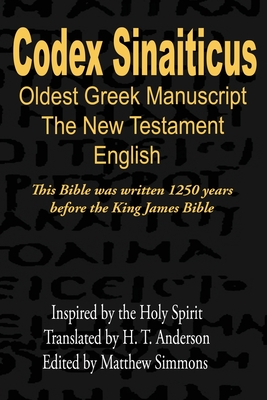Codex Sinaiticus: The Oldest Biblical Manuscript (English)

Codex Sinaiticus: The Oldest Biblical Manuscript (English)
Contains The New Testament Only (Matthew-Revelation)... This has been translated into English... See how certain verses were later added by the Scribes to the most modern Manuscripts of God's Word. This Bible is a great tool to compare the Oldest Manuscript with the Newer Manuscripts... God bless all of you!
What the Codex Sinaiticus is:
It is a manuscript of the Christian Bible, written in Greek in the middle of the fourth century.
It's one of the oldest and most complete manuscripts of the Bible and contains the earliest complete copy of the Christian New Testament.
It also contains portions of the Greek Old Testament (Septuagint) and two early Christian texts: the Epistle of Barnabas and the Shepherd of Hermas.
The manuscript is written on parchment (prepared animal skin).
Discovery of the Codex Sinaiticus:
It was discovered in the 19th century at St. Catherine's Monastery on Mount Sinai in Egypt.
German biblical scholar Constantin von Tischendorf found parts of the manuscript in 1844 and again in 1859.
The story surrounding its discovery, particularly Tischendorf's claim of finding it in a basket of discarded manuscripts, has been questioned by modern scholars.
Significance of the Codex Sinaiticus:
It's a crucial resource for understanding the history of the Christian Bible's text.
It provides insights into ancient book production and scribal practices.
Its presence in the Codex indicates that certain books, like the Epistle of Barnabas and the Shepherd of Hermas, were considered scripture by some Christians in the 4th century.
Where to view the Codex Sinaiticus:
The manuscript's leaves are now spread across four institutions: the British Library, the University of Leipzig, the National Library of Russia, and Saint Catherine's Monastery.
PRP: 247.92 Lei
Acesta este Prețul Recomandat de Producător. Prețul de vânzare al produsului este afișat mai jos.
223.13Lei
223.13Lei
247.92 LeiLivrare in 2-4 saptamani
Descrierea produsului
Contains The New Testament Only (Matthew-Revelation)... This has been translated into English... See how certain verses were later added by the Scribes to the most modern Manuscripts of God's Word. This Bible is a great tool to compare the Oldest Manuscript with the Newer Manuscripts... God bless all of you!
What the Codex Sinaiticus is:
It is a manuscript of the Christian Bible, written in Greek in the middle of the fourth century.
It's one of the oldest and most complete manuscripts of the Bible and contains the earliest complete copy of the Christian New Testament.
It also contains portions of the Greek Old Testament (Septuagint) and two early Christian texts: the Epistle of Barnabas and the Shepherd of Hermas.
The manuscript is written on parchment (prepared animal skin).
Discovery of the Codex Sinaiticus:
It was discovered in the 19th century at St. Catherine's Monastery on Mount Sinai in Egypt.
German biblical scholar Constantin von Tischendorf found parts of the manuscript in 1844 and again in 1859.
The story surrounding its discovery, particularly Tischendorf's claim of finding it in a basket of discarded manuscripts, has been questioned by modern scholars.
Significance of the Codex Sinaiticus:
It's a crucial resource for understanding the history of the Christian Bible's text.
It provides insights into ancient book production and scribal practices.
Its presence in the Codex indicates that certain books, like the Epistle of Barnabas and the Shepherd of Hermas, were considered scripture by some Christians in the 4th century.
Where to view the Codex Sinaiticus:
The manuscript's leaves are now spread across four institutions: the British Library, the University of Leipzig, the National Library of Russia, and Saint Catherine's Monastery.
Detaliile produsului










